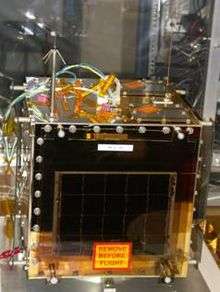FalconSAT

FalconSAT is the name of the United States Air Force Academy's small satellite engineering program. Satellites are designed, built, tested, and operated by Academy cadets. The project is administered by the USAFA Space Systems Research Center under the direction of the Department of Astronautics. Most of the cadets who work on the project are pursuing a bachelor of science degree in astronautical engineering, although students from other disciplines (typically electrical engineering, mechanical engineering, or computer science) join the project.
Compared to most commercial satellite projects, FalconSat is considerably lower budget, and follows a very accelerated development cycle. Because of the near total personnel turnover every year (the program is generally a senior cadet project, and graduating cadets must be replaced yearly) it forces the cadet engineers to very quickly learn and become familiar with the satellite systems to which they are assigned.
FalconSAT used to have a sister project, FalconLaunch, to design and develop sounding rocket class vehicles.
Satellites
- FalconGOLD – launched in 1997 on an Atlas rocket. Tested and proved the feasibility of using GPS to determine orbit position when outside the extent of the GPS constellation. Various web pages document FalconGOLD telemetry, a USAF Academy award, and an AIAA award. The design and launch team is documented on the AIAA award plaque. GPSWorld.com's October 1999 article declared "The results of this low-cost, off-the-shelf experiment were quite encouraging for the use of GPS at high altitudes." This work accelerated enthusiasm for GPS side lobe exploitation.[1]
- FalconSAT-1 – launched in January 2000 on a converted Minuteman II missile. It carried the CHAWS (Charging Hazards and Wake Studies) experiment developed by the Physics Department at the Academy. The satellite was successfully placed into orbit but was lost about a month later due to an electrical power system failure.[2] No useful science data was returned, despite repeated recovery attempts. The mission was declared a loss after about a month in orbit. A USAF press statement of June 2002 said: "While FalconSat-1 was a technical failure, it was a resounding academic success."[3]
- FalconSAT-2 – Significantly damaged when Falcon 1 launch vehicle failed seconds after launch. Despite the loss of the launch vehicle, the satellite landed, mostly intact in a support building for the launch vehicle. It was originally scheduled for launch on STS-114 with the Space Shuttle Atlantis in January 2003. Its payload was the MESA instrument (Miniaturized electrostatic Analyzer), which would have been used to sample plasma in the upper atmosphere. The data would have been used to correlate the effect of ionospheric plasma on trans-ionospheric radio communications.
- FalconSAT-3 – contains 5 experiments, including a gravity gradient boom, launch adapter shock ring, and several AFRL sponsored payloads, including MPACS (Micro Propulsion Attitude Control System), FLAPS (Flat Plasma Spectrometer), and PLANE (Plasma Local Anomalous Noise Experiment). The launch, aboard an Atlas V 401 from SLC-41 at Cape Canaveral Air Force Station, was scheduled to occur on 8 December 2006, however as this was on the same day as the scheduled launch of STS-116, and a 48-hour turnaround was required, it was delayed. Launch took place on 8 March 2007 alongside MidSTAR-1. While the FalconSAT-3 software architecture at launch limited access to all ADCS sensors, all scientific mission objectives were achieved. Bus software updates are ongoing, enabling enhanced visibility into satellite bus operations and payload performance.[4] In addition to providing both a ground and space based training platform, FalconSAT-3 was used as a trainer for cadets at West Point,[5] student officers at the Air Force Institute of Technology, and a ground station is in work at Vandenberg AFB, CA to support the Air Force's Space 100 course. In late September 2017, the Air Force transferred control of FalconSAT-3 to AMSAT for use by the amateur radio service for the 5–6 years of expected life remaining. Non-amateur radio frequencies were disabled. The satellite can be used as a packet radio bulletin board and as a digipeater.[6]
- FalconSAT-5 – was launched on 19 November 2010 on board a Minotaur IV. Though the $12,000,000 mission is listed on a NASA website here, data are not being made available to the public through that portal. Instead, all satellite information and data are maintained internally at USAFA, with no public information being released regarding the status of this mission.
References
- ↑
- ↑ Archived 29 July 2007 at the Wayback Machine.
- ↑ "eoPortal directory: FalconSat-1". Eoportal.org. Archived from the original on 19 March 2012. Retrieved 15 February 2012.
- ↑ "Academics - United States Air Force Academy" (PDF). Archived (PDF) from the original on 4 March 2016.
- ↑ "US Air Force Academy FalconSAT-3 Goes Joint With The Point (UAV) : Satnews Publishers". Satnews.com. Archived from the original on 12 January 2012. Retrieved 15 February 2012.
- ↑ "FalconSAT-3 Now Open for Amateur Radio Use". www.arrl.org. Archived from the original on 30 September 2017.
